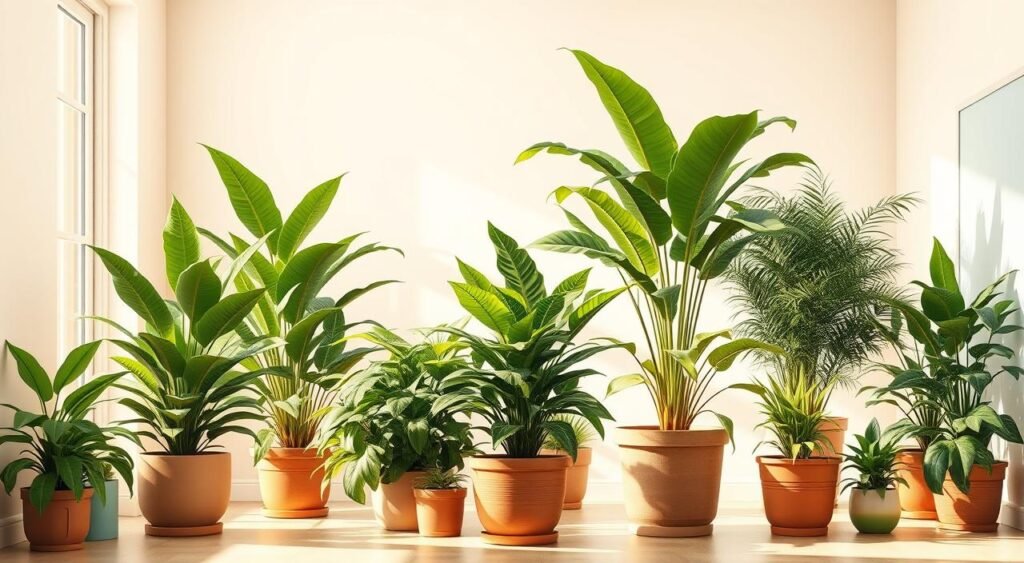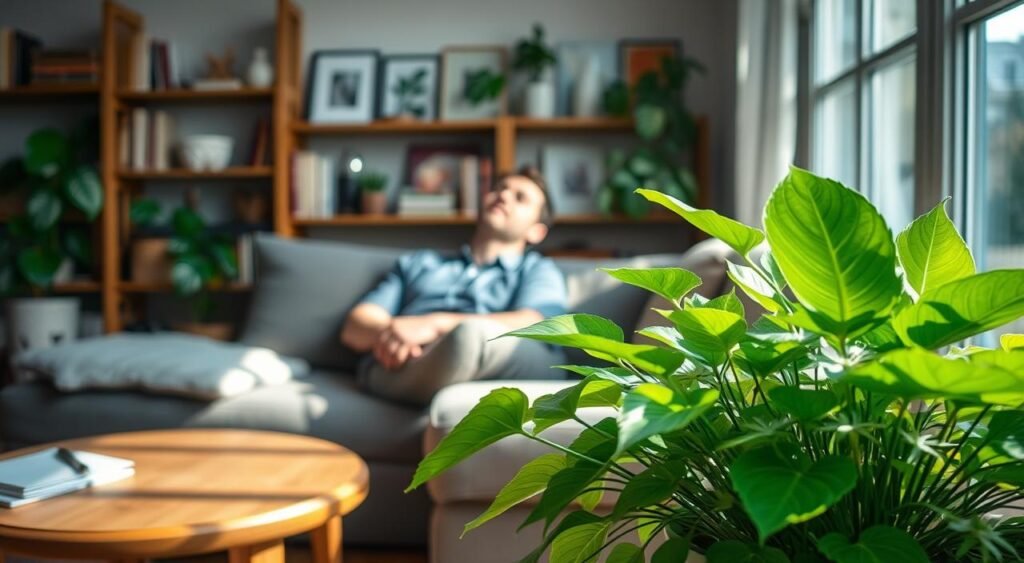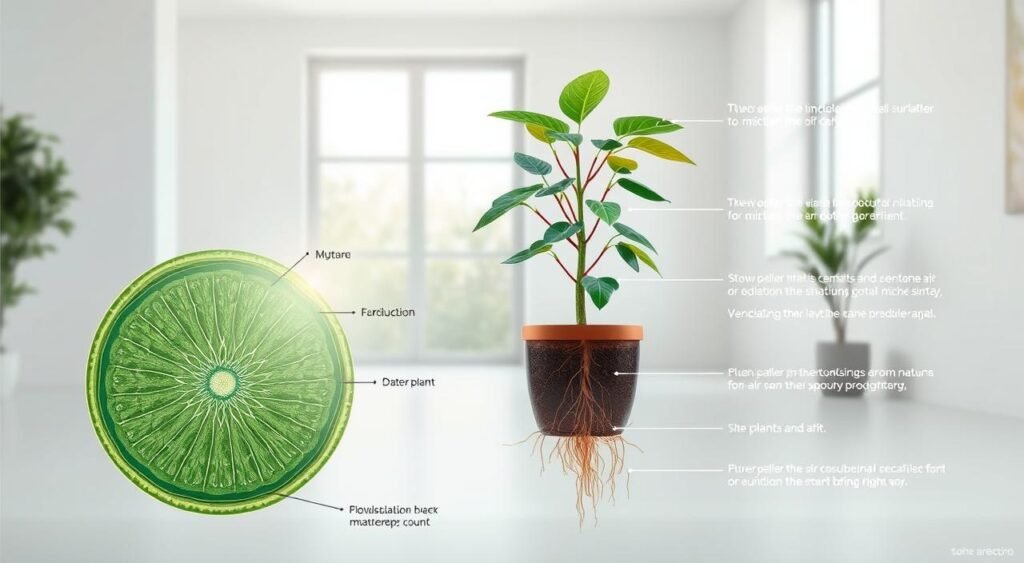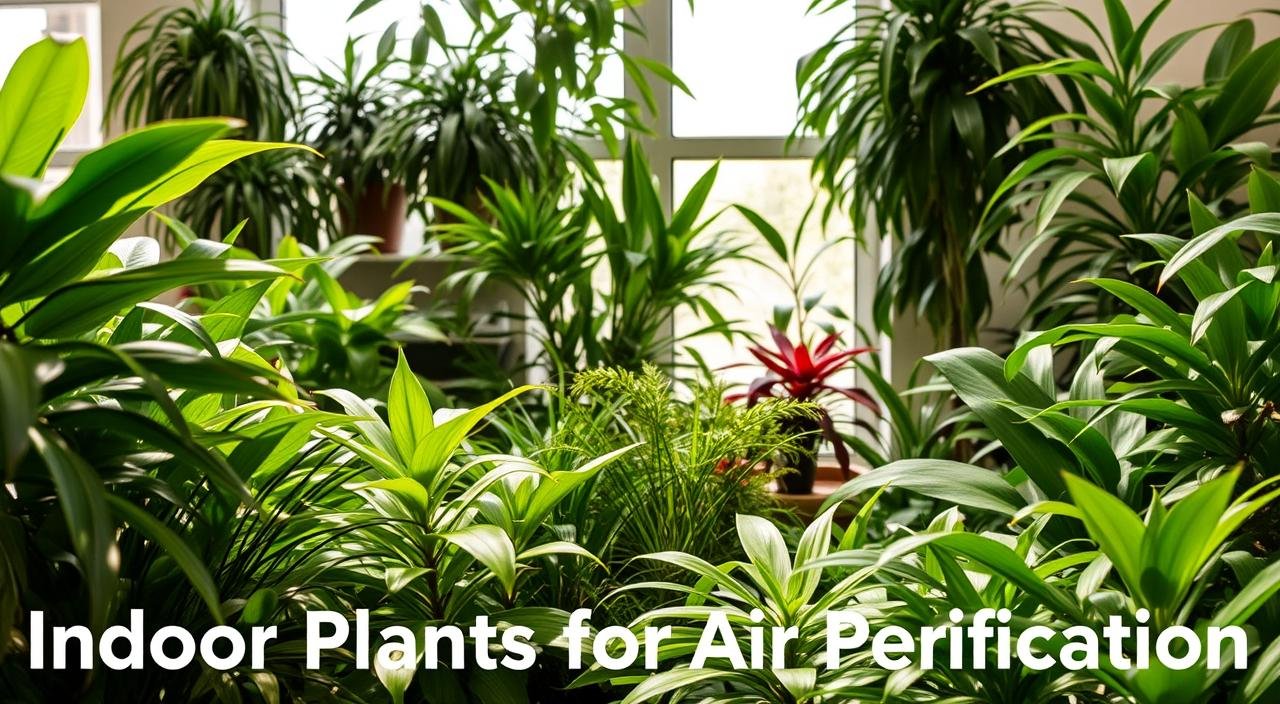A single Spider Plant can purify a 200-square foot room, neutralizing formaldehyde and carbon monoxide through its natural processes. NASA research confirms over 50 houseplants—including Pothos and Peace Lilies—remove VOCs like benzene and trichloroethylene from indoor air.
Plants like the Bamboo Palm eliminate both benzene and formaldehyde, while genetically modified Pothos ivy now targets chloroform. Snake Plants release oxygen at night, and Pothos can match the air-cleaning power of 30 regular plants in advanced systems.
Key Takeaways
- Spider Plants filter toxins in spaces up to 200 sq ft.
- NASA-endorsed plants like Peace Lilies remove formaldehyde and benzene.
- Pothos variants combat chloroform and VOCs through genetic advancements.
- Snake Plants boost nighttime oxygen levels.
- Pet owners must avoid Peace Lilies and English Ivy due to toxicity.
What are Indoor Plants?
Indoor plants are living organisms grown inside homes or offices. These plants thrive in controlled environments, differing from outdoor varieties by adapting to limited space and artificial light. Indoor gardening involves nurturing these plants to flourish without natural outdoor conditions.
Definition and Types
Common types include flowering plants like Peace Lilies, foliage plants such as Fiddle Leaf Figs, succulents like String of Pearls, and air plants like Tillandsia. Retailers often categorize them by traits like pet safety or air-purifying abilities. Popular choices like Snake Plants (Sansevieria) or Spider Plants (Chlorophytum comosum) are known for hardiness.
Importance in Home Environment
Indoor plants improve air quality by absorbing toxins. A 2004 study noted they boost focus and mood in sterile spaces. They also add visual appeal, reducing stress through biophilic design principles. During the pandemic, sales surged as 30% of U.S. households bought plants for mental well-being.
A 2004 controlled study found houseplants improve mental focus and motivation in plain environments.
| Plant Type | Key Trait | Reference |
|---|---|---|
| Snake Plant | Needs minimal water (1x/month) | kkk3 |
| Peace Lily | Purifies air, weekly watering | kkk3 |
| ZZ Plant | Tolerates low light | kkk2 |
Choosing the right plant starts with an indoor plant guide matching light, space, and care needs. Options like the Snake Plant or Spider Plant offer low-maintenance solutions for beginners.
How Indoor Plants Purify Air

Indoor plants improve air quality through natural processes that go beyond basic photosynthesis. Their ability to filter pollutants stems from biological mechanisms, enhancing indoor plant benefits
Plants absorb carbon dioxide and release oxygen during photosynthesis, but their role in air purification goes further. Stomata—tiny leaf pores—also pull in airborne chemicals. NASA studies show common houseplants remove formaldehyde and benzene.
The Process of Photosynthesis
Leaves intake carbon dioxide and release oxygen, but roots and soil microbes play a role too. Microorganisms in soil break down VOCs, while roots act as a filtration system. This dual action makes plants natural air cleaners.
Common Pollutants Filtered
Indoor plants target specific harmful substances:
- VOCs: Formaldehyde (from furniture) and benzene (from paints) are absorbed through leaves and soil microbes.
- Microbes: Studies show plants reduce airborne microbes by 50%, lowering pathogens in indoor spaces.
| Pollutant | Source | Plants Effective |
|---|---|---|
| Formaldehyde | Adhesives | Snake Plant |
| Benzene | Cleaners | Spider Plant |
These mechanisms make indoor plant benefits scientifically proven. Plants work 24/7 to clean your home’s air without electricity.
Best Indoor Plants for Air Quality
Choosing the best indoor plants means selecting varieties proven to clean the air while thriving in home conditions. NASA research highlights plants like the Snake Plant and Bamboo Palm as top performers in removing pollutants. Below are four standout options backed by science and customer reviews.
| Plant | Pollutants Removed | Care Tips |
|---|---|---|
| Snake Plant | Formaldehyde, benzene, xylene | Low light, minimal watering |
| Spider Plant | Formaldehyde, xylene | Thrives in bright indirect light |
| Peace Lily | Ammonia, benzene | Keep soil moist, avoid direct sun |
| Bamboo Palm | Formaldehyde, trichloroethylene | Prefer humid environments |
Snake Plant stands out for releasing oxygen at night, making it ideal for bedrooms. Spider Plants rate highly in customer reviews with 4.8/5 stars for ease of care. Peace Lilies remove VOCs from cleaning products, while Bamboo Palms can reach 6 feet tall, increasing surface area for filtration. Always consider pet safety—Peace Lilies and Dracaena are toxic if ingested. Pair these plants with proper ventilation for optimal results.
For maximum impact, place at least two plants per 100 square feet. Their natural filtration works best when combined with regular dusting and humidity control. These best indoor plants not only improve air quality but also add beauty to living spaces.
Benefits of Indoor Plants Beyond Air Quality

Indoor plant benefits extend far beyond cleaner air, offering mental and physical health boosts. By reducing stress hormones and enhancing home aesthetics, these green companions create spaces that promote well-being. Proper plant care ensures these advantages thrive alongside their air-purifying roles.
Stress Reduction
Research reveals plants lower stress hormones. A study found interacting with indoor plants reduced stress responses by up to 30%. Another study showed gardening tasks lowered heart rate compared to screen-based activities. Plants like the Snake Plant and Peace Lily act as natural stress buffers, aligning with human biophilia—the innate connection to nature.
| Plant | Stress-Reducing Trait |
|---|---|
| Snake Plant | Stabilizes mood through oxygen release |
| Peace Lily | Encourages calmness with moisture release |
Improved Aesthetics
Houseplants transform spaces into calming environments. A 70% surge in plant sales reflects growing interest in using them for decor. Plants like the Boston Fern add organic texture, while trailing vines soften harsh corners. A 2004 study noted improved creativity in rooms with greenery.
Increased Humidity Levels
Via transpiration, plants like the Boston Fern and Areca Palm release moisture, raising humidity by up to 10%. This reduces dry skin and soothes respiratory issues. Opt for humidity-loving plants like the Peace Lily to maintain optimal home moisture without overwatering.
Tips for Choosing the Right Indoor Plants
the right indoor plants starts with understanding three key factors: light, maintenance, and space. This indoor plant guide highlights how to match plants to your home’s conditions. Assessing plant lighting needs is crucial, as incorrect levels can stress plants.
Light Requirements
Light preferences vary by species. Use a simple test: hold your hand 12 inches above the floor. Sharp shadows signal bright light; blurry shadows mean medium; no shadow indicates low light. Plants like the Snake Plant (Sansevieria) thrive in low light, while Croton needs 2–3 hours of direct sun. Categories include
- Bright direct (full sun)
- Bright indirect
- Medium indirect
- Low indirect
. Tropical varieties like Philodendron adapt to fluorescent office lights.
Maintenance Level
Start with low-maintenance options like Pothos, which survives in low light and needs weekly watering. Overwatering kills more plants than drought. Self-watering pots from brands like My City Plants reduce effort, needing water every 3 weeks initially. Check labels for pet-friendly tags if you have animals.
Size Considerations
Verify mature sizes. Peace Lilies grow 2–3 feet tall, while Ficus can reach 8 feet indoors. Leave 6 inches between plants and furniture to avoid humidity buildup. Prune fast-growing varieties like Monsteras to control size. Compact options like Mini Monstera fit small spaces.
Creating a Green Space in Your Home

Transform any room with indoor plant decor that combines style and function. Strategic placement and creative styling turn plants into both air-purifying tools and design statements. Over 75% of plant owners report improved mood and relaxation, making them essential for modern living spaces.
Start by selecting spots where plants thrive while enhancing decor.
- Hanging Pothos or Philodendron add vertical flair, ideal for small spaces. These trailing plants thrive in indirect light and suit minimalist aesthetics.
- Cluster plants near electronics or kitchens to target pollutants. Snake Plants and Peace Lilies remove toxins like formaldehyde, improving air quality in high-traffic areas.
- Use plant stands or shelves to create focal points. Tiered displays add depth, pairing well with contemporary or bohemian styles.
Blend plants with existing decor by choosing planters that match room themes. Terracotta pots contrast rustic settings, while sleek ceramic vessels complement modern layouts. Monstera plants add tropical energy, while succulent arrangements fit minimalist schemes.
Indoor plants reduce stress by 37% and boost well-being through their calming presence.
Begin with low-maintenance favorites like ZZ Plants or Pothos. Their adaptability makes them perfect for beginners, aligning with the surge in first-time plant owners. Even small spaces can shine with a tiny succulent garden, proving that indoor plant decor doesn’t require large investments.
Pair plants with complementary styles—group ferns in bathrooms for humidity-loving greenery or line shelves with trailing pothos for a lush vignette. By merging practicality and beauty, indoor plant decor becomes a science-backed upgrade for any home.
Caring for Indoor Plants
Effective plant care starts with understanding the basics of plant watering and routine maintenance. Over 60% of plant deaths stem from incorrect watering habits, so mastering this step is critical.
| Plant | Spring/Summer | Winter | Notes |
|---|---|---|---|
| Snake Plant | Once weekly | Once monthly | Avoids root rot |
| Pothos | When soil dries 2″ deep | Every 3-4 weeks | Thrives with infrequent watering |
| Peace Lily | When topsoil feels dry | Reduce frequency | Avoids overwateringing |
Watering Needs
Adjust plant watering based on seasonal changes. Most houseplants need reduced watering during winter due to slower growth. Use your finger to check soil moisture 2″ deep before watering.
Fertilization Tips
- Use diluted fertilizers during active growing seasons (March-September).
- Snake plants need fertilizer once in spring; pothos prefer monthly water-soluble feeds.
- Skip fertilization in winter for most varieties.
Pest Control
- Inspect leaves weekly for pests like mealybugs or spider mites.
- Isolate infested plants and treat with neem oil or insecticidal soap.
- Maintain airflow with fans to prevent stagnant conditions.
Proper plant care also includes checking soil drainage and rotating plants weekly for even light exposure. Over 80% of pest issues arise from poor watering practices.
Understanding the Science Behind Air Purification

Decades of research confirm indoor plants improve air quality through natural processes. The NASA Clean Air Study proved certain species remove volatile organic compounds (VOCs), while recent studies explore their role in reducing airborne pathogens during pandemics.
Key Studies and Findings
Lab experiments reveal plants absorb toxins like formaldehyde and benzene. A 2022 study found indoor plants paired with HEPA filters reduced viral aerosols by 50%. Data shows HEPA systems alone capture 99.97% of 0.3 µm particles, while plant-based systems require 680+ plants for full home coverage.
| Purification Method | Efficacy | Key Factor |
|---|---|---|
| HEPA Filters | 99.97% (0.3 µm particles) | Requires regular replacement |
| Plant-TiO₂ Systems | 60–80% bacterial reduction | Needs UV light activation |
| Plant Arrays | Variable | Optimal with 2-3 plants/100 sq ft |
Expert Opinions
“Plants are part of a layered strategy—not standalone solutions”
— Environmental Health Journal. Researchers emphasize combining methods: HEPA filters handle particulates while plants target chemical pollutants. A 2021 study found dual systems remove 92% of VOCs vs. plants alone at 15%.
While indoor plants offer proven benefits like stress reduction, their air purification role works best with modern filtration tech. Strategic use maximizes indoor plant benefits for healthier homes.
Indoor Plant Myths Busted
Houseplants boost air quality, but misconceptions often cloud their true benefits. Let’s clarify the science behind their air-purifying role and separate fact from fiction.
Debunking Common Misconceptions
Common myths include:
- Myth 1: One plant can purify an entire room.
- Myth 2: All houseplants clean air equally.
- Myth 3: Plants are unsafe in bedrooms at night due to oxygen consumption.
Evidence-based Facts
Here’s what science confirms:
- Quantity matters: Studies show 4-6 plants per 100 sq ft are needed for measurable air improvement. Snake plants and bamboo palms lead in efficiency.
- Varied effectiveness: Snake plants excel at night, while pothos thrives in low light. Efficiency depends on species.
- Nighttime safety: At night, plants respire but consume minimal oxygen. Even in enclosed rooms, human needs far outweigh plant oxygen use.
| Myth | Fact |
|---|---|
| One plant = clean air | 4-6 plants needed per room |
| Plants are night dangers | Oxygen use negligible; safe for bedrooms |
Proper care maximizes benefits. Check soil moisture before watering and avoid strict schedules. Prioritize species like peace lilies for optimal results.
Getting Started with Indoor Plants
Transforming your home into an air-purifying sanctuary starts with choosing the right plants and resources. A reliable indoor plant guide simplifies the process, whether you’re selecting from starter kits or visiting local retailers. Begin by evaluating your space’s light and temperature conditions to match them with plant needs.
Starter Kits and Resources
Starter kits often include essentials like well-drained terracotta pots with drainage holes and pre-mixed soils. Pennington Rejuvenate Potting Soil or Alaska Fish Fertilizer 5-1-1 provide balanced nutrients for healthy growth. Apps like Plantjoy or books like “The New Plant Parent” offer troubleshooting tips, such as addressing overwatering signs like root rot. Beginners should prioritize low-maintenance options like Snake Plants or Spider Plants, which thrive in 60-85°F temperatures.
Local Plant Shops and Nurseries
Local nurseries offer tailored advice on acclimating plants to your home’s humidity levels. For instance, Calatheas prefer 30-65% humidity, achievable with misting or humidity trays. When purchasing, inspect for signs of dormancy—some plants like Pothos need reduced watering during rest periods. Ask sellers about light requirements; for example, Fiddle Leaf Figs need bright indirect light, while ZZ plants tolerate low light. Avoid overcrowded pots to prevent root rot, and always repot in increments to match plant size.
With the best indoor plants and proper care, even first-time growers can create a thriving green space. Prioritize quality resources, local expertise, and plant-specific needs for lasting success.
FAQ
What are the best indoor plants for air purification?
Some of the best indoor plants for air purification include the Snake Plant, Spider Plant, Peace Lily, and Bamboo Palm. These plants are known for their ability to filter out common indoor pollutants effectively.
How do indoor plants improve air quality?
Indoor plants improve air quality through a process called photosynthesis, where they absorb carbon dioxide and release oxygen. They can also filter out harmful volatile organic compounds (VOCs) like formaldehyde and benzene.
What types of indoor plants are suitable for low light conditions?
Suitable indoor plants for low light conditions include the Snake Plant, ZZ Plant, and Pothos. These plants are adaptable and can thrive in areas with minimal sunlight.
How often should I water my indoor plants?
The watering frequency for indoor plants varies based on the plant species and environmental conditions. Generally, it’s best to check the top inch of soil; if it’s dry, it’s time to water.
Do indoor plants have any psychological benefits?
Yes, indoor plants can reduce stress and anxiety, improve mood, and enhance concentration. Engaging with nature, even indoors, satisfies the psychological concept of biophilia.
Can all indoor plants purify air equally?
No, not all indoor plants purify air equally. Certain plants are more effective at filtering specific pollutants than others. Research indicates variations in the air-purifying capabilities among different species.
How do I choose the right indoor plants for my home?
Consider factors like light levels, maintenance requirements, and the plant’s mature size when choosing indoor plants. Assess your living conditions to match the right plant to the right location.
Are there any common pests I should watch out for with indoor plants?
Common pests include spider mites, scale, and mealybugs. Regularly inspecting plants and maintaining a clean environment can help prevent pest infestations.
What resources are available for beginners starting indoor gardening?
Beginners can find starter kits, plant care apps, and online communities to support their indoor gardening journey. Local plant shops also offer guidance tailored to specific conditions.
Is it true that plants consume oxygen at night?
While it’s true that most plants take in oxygen and release carbon dioxide at night, some plants, like Snake Plants, can perform photosynthesis even during the night, providing oxygen.
Source Links
- The 10 Best Houseplants For Cleaning Indoor Air | Wagners Greenhouse – https://www.wagnergreenhouses.com/blog/top-10-best-air-purifying-houseplants/
- 10 Best Houseplants for Air Purification and Low-Light Environments – https://www.cnet.com/home/kitchen-and-household/the-best-houseplants-for-air-purification-and-low-light-environments/
- Houseplant – https://en.wikipedia.org/wiki/Houseplant
- These Hard-to-Kill Houseplants Are Great for Beginners – https://www.goodhousekeeping.com/home/gardening/advice/g1285/hard-to-kill-plants/
- Best Indoor Plants | House Plants & Indoor Trees | Lively Root – https://www.livelyroot.com/collections/indoor-plants?srsltid=AfmBOoro39GpcnDdsKXqNVZfMfoS001LhwEiBxo-H5R1HlQ2n6YEASGM
- Houseplants That Clean the Air – Gardening Solutions – https://gardeningsolutions.ifas.ufl.edu/plants/houseplants/houseplants-that-clean-the-air/
- Frontiers | The Role of Indoor Plants in air Purification and Human Health in the Context of COVID-19 Pandemic: A Proposal for a Novel Line of Inquiry – https://www.frontiersin.org/journals/molecular-biosciences/articles/10.3389/fmolb.2021.709395/full
- NASA compiles list of best plants to clean indoor air – https://www.co2meter.com/blogs/news/nasa-compiles-list-of-best-plants-to-clean-indoor-air?srsltid=AfmBOoqpT1vAQ2tXDYahxb4kdqOq8Goh8J9yjL7rPX8SN9986bmo1glG
- 7 Best Air Purifying Indoor Plants | Air Health – https://airhealth.com/blog/7-best-air-purifying-indoor-plants-air-health/?srsltid=AfmBOopt4rPjTKP7MrKQH1qRbxgQsNtx1_KSgYaXTIYxuCRqvN0xq2jK
- Air Purifying Plants for Your Office – https://kitchenerclean.com/blog/air-purifying-plants
- Health Benefits of Indoor Plants – https://www.zerorez.com/blog/health-benefits-of-indoor-plants
- 7 Science-Backed Benefits of Indoor Plants – https://www.healthline.com/health/healthy-home-guide/benefits-of-indoor-plants
- Selecting Indoor Plants | University of Maryland Extension – https://extension.umd.edu/resource/selecting-indoor-plants
- Your Guide to Choosing a Plant for Every Room in Your House – https://www.realsimple.com/home-organizing/gardening/indoor/best-indoor-plants
- Home Plant Guide: How To Choose The Best Plants For Your Home, Where to Place Them, & How to Care for Them • My City Plants – https://mycityplants.com/plant-decor/how-to-choose-the-best-plants-for-your-home/
- The Importance of Green Spaces: How Indoor Plants Can Help – https://www.houseplant.co.uk/blogs/houseplants/the-importance-of-green-spaces-how-indoor-plants-can-help
- Creating a Plant Oasis At Home — black & blooms – https://www.blackandblooms.com/blog/creating-a-plant-oasis-at-home
- The Art of Indoor Plant Arrangements: Transforming Your Home into a Green Oasis – https://soltech.com/blogs/blog/the-art-of-indoor-plant-arrangements-transforming-your-home-into-a-green-oasis?srsltid=AfmBOorosSYBWUmTltWQk-T2dYmp90nGv16kYdO_YKXLTwBsjWljXqeL
- Guide to Basic Care of Houseplants | Gardener’s Path – https://gardenerspath.com/how-to/indoor-gardening/houseplant-care-primer/
- Top Ten Plant Care Tips for Houseplants & Indoor Plants – The Sill – https://www.thesill.com/blogs/plants-101/top-ten-plant-care-tips?srsltid=AfmBOoqe3J9ejeQkoeu54HSj9nh_WFy1Hc90mAgVVxeqoM8ldkkvQQfN
- Can Plants Purify Indoor Air? – https://www.healthline.com/health/air-purifying-plants
- The Role of Indoor Plants in air Purification and Human Health in the Context of COVID-19 Pandemic: A Proposal for a Novel Line of Inquiry – https://pmc.ncbi.nlm.nih.gov/articles/PMC8279815/
- Houseplant Myths Debunked: Separating Fact from Fiction – Green Side Up Garden & Gifts – https://www.greensideupgifts.com/houseplant-myths-debunked-separating-fact-from-fiction/
- 7 Indoor Houseplant Myths That Fooled Us Too – https://www.lovethatleaf.co.nz/blogs/plant-care-guides/indoor-house-plant-myths?srsltid=AfmBOorHph0K0nNVK1OoRM3cwuJKtK9VzjbcozbtGt6PtRPzQitR0_qt
- 15 Easy Indoor Plants for Beginners – Can’t Kill Houseplants – https://www.provenwinners.com/leafjoy/easy-indoor-plants
- How to Grow and Take Care of Indoor Plants – https://www.pennington.com/all-products/fertilizer/resources/8-steps-to-growing-a-healthy-indoor-garden-anytime
- Growing plants indoors: A beginner’s guide — HOMESTEAD BROOKLYN – https://homesteadbrooklyn.com/all/2017/1/21/growing-plants-indoors-a-beginners-guide


Incredibly useful….looking ahead to coming back.
Thank you very much for your valuable comment.